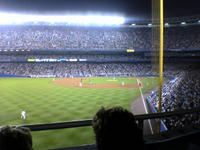Will Hunter's Injury Spell Disaster?
The loss of Torii Hunter appears devastating to a team already in offensive dire straits. If nothing else, making the front page of espn.com means that Hunter's loss must be big news, possibly spelling the end of 2005 for the Twins and an October at home for the first time since 2001. After losing their first three games without Hunter to the Red Sox (counting the game in which he was injured in the first inning), the team now stands at 54-50, 14 games behind the White Sox and 4 games behind the A's in the Wild Card chase. I can't help but thinking Terry Ryan chose not to mortgage the future on Youkilis/Cruz or Soriano at least partially because he saw the rest of the season as a lost cause.
Will Carroll knows more about baseball injuries than almost anyone, so I'll default to his pessimistic reaction to Hunter's injury. Torii doesn't have a terribly long injury history, so we don't know all that much about his typical recovery time, but we can safely say that slow-healing ankle ligament injury is going to pretty damaging for a player who gets much of his value from speed. The front office is obviously aware of all of these factors, so Hunter probably won't be rushed back into a losing situation if it means any additional risk of coming back at less than full strength in the future. What I'm getting at here is that I don't expect to see him patrolling CF at all the rest of the season.
But the real question is whether Torii's injury will have much of an impact on the offense, as Lew Ford should be a decent offensive replacement, at least in theory, and Matt Lecroy should get most of the rest of the ABs. The team is already in a free fall, and the offense was looking pretty hopeless even with Torii's solid contributions, so the importance of the injury may be little more than the icing on the cake, or the bow on the journalists' neatly packaged "Twins' 05, Year in Review" story due in newspapers in mid-October. I've chosen to use the same Marginal Lineup Value Rate tool that I used to measure the impact of different versions of Bret Boone to the lineup. As a quick review, MLVr measures the contribution one player can make to a league average offense. Since the Twins are below league average, negative contributions will be overstated and positive ones understated. In other words, a good offensive player is particularly valuable to a bad lineup, which was the case with Torii's productive 2005. Here's a more complete picture of what we stand to lose, assuming Ford takes over in CF and Lecroy gets most of the extra PAs by taking Ford's DH spot (I used Lecroy's career stats because he only has 151 ABs on the season, which may present too optimistic of a forecast):
League Average Lineup: .269/.330/.426, 794.44 Runs
Hunter: .269/.337/.452, 803.53 Runs, 9.09 Runs added/162, MLVr = .056
Lecroy: .265/.325/.450, 796.59 Runs, 2.15 Runs added/162, MLVr = .013
Over a full season, Hunter's 2005 has been about 7 runs better than Lecroy's career line. Maybe Lecroy's outlier short season actually demonstrates real improvement, but the greater likelihood is that he just hasn't played enough games for his stats to average out yet, and he has been the beneficiary of careful use: good platoon advantages and lots of rest. Seven runs is enough to pay attention to, but isn't the huge offensive loss that we would assume from losing our perceived best player. With only 58 games to play, the difference is even less.
Hunter: +3.25 runs
Lecroy: +.75 runs
Offensively, Hunter's injury should only cost the Twins about 2.5 runs if Lecroy regresses to his career stats. But Hunter's perceived value has long been in his glove. His fielding, however, has slowly declined since he passed his physical peak and accumulated minor nagging injuries by playing his all-out, Superman style. He has still put up a Rate2 of 104 in CF this year, making him good for 4 runs over average every 100 games. By comparison, Ford has a career Rate2 of 96 in CF, a more meaningful number than the single-season datum since he's only seen action in 14 games there this year. With only 58 games remaining, the defensive switch will cost somewhere around 4.5 runs, for a total loss of about 7 runs due to losing Hunter.
It's not surprising that Hunter's offensive is more easily replaced than his defense, but it is surprising how little the Twins stand to lose from his injury. Seven runs probably won't even make one full win of difference for the rest of the season, so anyone pinning the Twins' demise on Hunter's injury would be badly mistaken.










